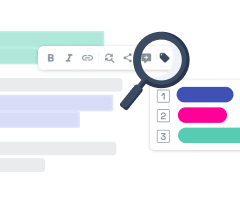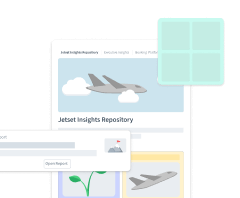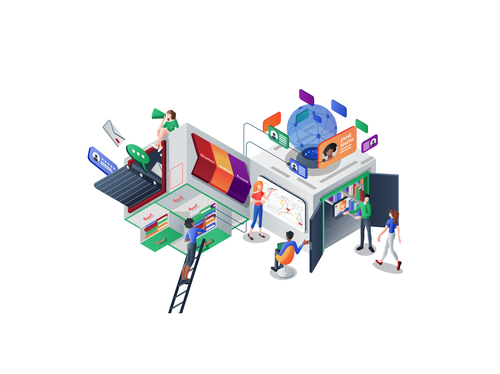
Repository Retrospective: Learnings from Introducing a Central Place for UX Research
While many researchers see the value of a central research repository, how to introduce one in an organization is still a big question. And who better to learn from than two researchers who have done this themselves recently. So we invited two researchers, who just introduced Condens as their research repository to share their process and experience gained.
Taylor Jennings, Senior UX Researcher at Chili Piper, and Joe Nelson, User Experience Researcher at MasterControl, spoke about their learnings from introducing a central place for UX Research, how they realized the need for a repository, how they convinced stakeholders, evaluated solutions, and what they’d do differently in hindsight.
This is a summary of our conference panel “Repository Retrospective: Learnings from Introducing a Central Place for UX Research.” You can watch the full talk here.


- Starting Point 🛫
- When did you realize the need for a research repository?
- What was the main thing you wanted to achieve by introducing a repository?
- Were there any hesitations in introducing a research repository?
- Evaluation: How did you evaluate different solutions, and what were the main criteria you were looking for? ↔️
- Implementation of a central research repository 👋
- What kind of data makes it into your repository?
- Who uses your repository, and for what purposes?
- How did you approach categorizing your data and your taxonomy?
- How do you ensure the repository stays up to date?
- Learnings 💡
- What surprising insights have you made?
- What you would do differently in hindsight?
- Watch full talk 🎥
When did you realize the need for a research repository?
Taylor described that different teams were already doing research at her company, but there was no central place to store it and no central format. Also, the question of how people can access research insights arose. The team at ChiliPiper realized that this was something to work on, especially since they just had their first UX Researchers, and the team wanted to scale and continue research efforts.
Joe described a different starting point: The team already had an older repository that didn’t serve their needs anymore. They were aiming for a more intuitive and more robust repository. They were especially missing a way for others to get information from research data quickly. For the team at MasterControl, this included more than just technical access. They were looking for a more engaging way that makes stakeholders interested in exploring research findings. Also in their point of view, the researchers spend too much of their time preparing slide decks to make research findings more digestible for stakeholders.
What was the main thing you wanted to achieve by introducing a repository?
Both researchers had similar primary goals of introducing a research repository:
Creating a central place for research: One of the main goals when introducing a research repository was to create a place for people to go when they have questions that allow researchers and non-researchers to self-serve existing research findings.
Speed-to-Insight-Optimization: This goal refers to the needed time to come from raw research data to a shareable video or multimedia report of research insights. For example, the team at ChiliPiper identified that to improve their 'Speed-to-Insight', they need to cut down on the time of working with transcripts, creating notes, and creating slides. For Joe and the team at MasterControl, this was also about reducing the number of tool and context switches.
Want to learn more about the different functions a UX research repository can have? Head over here:
Were there any hesitations in introducing a research repository?
Taylor joined her team as the first UX Researcher. From her point of view and experience with working with repositories, especially as a small team, a repository and process around storing research data and insights helps to establish UX research practice and save much time. So for them, it was clear that it was the right thing to focus on, especially as a small team.
Our speakers had different experiences regarding the need to convince people in the organization. For Joe, this was about showcasing the need for a repository and involving different roles in evaluating solutions. Taylor helped convey the conceptual advantages of a repository and did not need any further persuasion. Nonetheless, she took a deeper look at the goals and requirements for a solution that fit the research environment at ChiliPiper and determined how she wanted to compare solutions. Check out how Taylor compared different solutions and choose their research repository.
Evaluation: How did you evaluate different solutions, and what were the main criteria you were looking for? ↔️
Both Joe and Taylor have put together criteria to evaluate different solutions to support their research needs. This included, among others:
Secure storage and management of participant data
A system to track participant data and who was involved in studies
A faster way to come to research insights, including some feature requirements like automatic transcription, affinity mapping, and tagging
Intuitive usage
Migration of existing research data from other platforms
Some business requirements, like user authentification via Single-Sign-On
What kind of data makes it into your repository?
Both teams store raw research data and their findings in the research repository. Their central repository contains, for example, video recordings, transcripts, surveys, notes from research sessions, and contextual documents that participants or customers have shared with them. By having everything in one structured place, each user can dive in as deep as they need to:
„Stakeholders can go in and very quickly look at the published report. If the product manager or designer wants more, they can go in and read individual transcripts. It's like everybody can self-serve the information in the way that works best for them. It's really helpful to have both the raw and finalized insights in there.“

Who uses your repository, and for what purposes?
There are different user types for the central research repositories Taylor and Joe describe:
Researchers, who are actively adding new research data, analyze data and create Conclusions
Stakeholders, like Product Managers and Designers, who are consuming research insights and dig deeper into watching research sessions or exploring more contextual information from time to time
Stakeholders, like executive managers, who are consuming summarized research reports
How did you approach categorizing your data and your taxonomy?
Categorizing research data with tags was one core functionality both teams aimed for.
A tag is used to categorize raw research data like statements from participants and observations in a way that a good share of future questions can be answered quicker, with less effort, and more precisely. An effective taxonomy helps to extract insights without having to go through every research session again or conducting new research.
Taylor and Joe use different tag sets for different use cases: They work with project-specific tags and global tags, that can be applied in multiple research projects.
For the global tags, they have come up with a set of tags they aligned with their teams upfront. Those global tags collect information that is interesting outside of the single study, and are centered around, for example:
stages of their customers’ journey
general pain points
their products
Marketing and Sales related topics
Both Joe and Taylor follow a more loose approach with the project tags, which they create in a more flexible way.
How do you ensure the repository stays up to date?
As the main analysis of their research data happens in the same place, Taylor describes that the repository keeps itself up to date without the need of additional archiving. Besides that, they initially created a practical taxonomy for their research setting and evaluate it from time to time.
What surprising insights have you made?
Beyond expected effects, Joe and Taylor shared a few unexpected observations:
Sharing multimedia highlights with stakeholders was even more effective than expected: Taylor described that she could 'watch' the stakeholders having AHA moments when diving into real user experiences with video highlights. This functionality will support creating a deeper understanding of the experience, especially when compared with text summaries. Read more about why we think UX research should double down on the emotional depth of research findings.
Joe described an unexpected positive effect when working with the split-screen mode in Condens, which allows you to quickly drag and drop research highlights to a work-in-progress area and start affinity diagramming from any position.
Bringing others into the research repository requires constant communication: Both stated that it’s essential to refer to the repository in every communication as the place where relevant research information comes from and can be accessed to really implement it in the organization’s workflows.
What you would do differently in hindsight?
In hindsight, there were some things that Taylor and Joe would have done differently with the experience they gained from introducing a central research repository. There are two main areas they would approach slightly differently now:
Insisting on the advantages of a repository sooner: After seeing the benefits of a central research repository for the researchers’ work and the whole organization, in hindsight, they wished that they had insisted on the advantages of a repository even earlier to create the central place for UX Research.
„Find something that streamlines your process as a researcher. There was a lot of time spent going from one place to another, doing the synthesis and the summarization with different tools. Now we can talk to PMs and more stakeholders about doing more research. So I would have pushed harder earlier for something that streamlines our process.“
 User Experience Researcher, MasterControl
User Experience Researcher, MasterControlGetting everyone on board from the beginning: Taylor states that even with the central repository in place, interesting information from customer conversations is still not making its way in. So in hindsight, she would have involved more roles in implementing the repository and making them more familiar with it right from the start.
Watch full talk 🎥
/f/99166/1664x936/9bc184d44b/yt-thumbnail-repository-retrospective.png)
Want to read more? Check out our articles about what a UX research repository can do for you and the design considerations behind a research repository.







